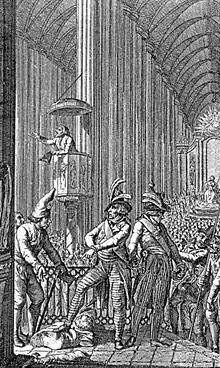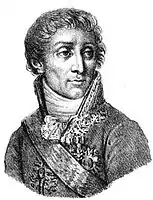Cult of Reason
The Cult of Reason (French: Culte de la Raison)[note 1] was France's first established state-sponsored deistic religion, intended as a replacement for Catholicism during the French Revolution. After holding sway for barely a year, in 1794 it was officially replaced by the rival Cult of the Supreme Being, promoted by Robespierre.[1][2][3][4] Both cults were officially banned in 1802 by Napoleon Bonaparte with his Law on Cults of 18 Germinal, Year X.[5]

Origins
Opposition to the Roman Catholic Church was integral among the causes of the French Revolution, and this anti-clericalism solidified into official government policy in 1792 after the First French Republic was declared. Most of the dechristianisation of France was motivated by political and economic concerns, and philosophical alternatives to the Church developed more slowly. Among the growing heterodoxy, the so-called Culte de la Raison became defined by some of the most radical revolutionaries like Jacques Hébert, Antoine-François Momoro, Pierre-Gaspard Chaumette, and Joseph Fouché.
Composition
Considerable debate has always persisted about the religiosity of the Cult of Reason.[6] It was a hodgepodge of ideas and activities, a "multifarious phenomenon, marked by disorderliness".[7] The Cult encompassed various elements of anticlericalism, including subordination of priests to secular authority, wealth confiscation from the Church, and doctrinal heresies both petty and profound.[7] It was atheistic,[8][9] but celebrated different core principles according to locale and leadership: most famous was Reason, but others were Liberty, Nature, and the victory of the Revolution.[7]
Antoine-François Momoro

One of the more philosophical proponents was Antoine-François Momoro in Paris. In his hands, the capital city's Cult of Reason was explicitly anthropocentric. Its goal was the perfection of mankind through the attainment of Truth and Liberty, and its guiding principle to this goal was the exercise of Reason. In the manner of conventional religion, it encouraged acts of congregational worship and devotional displays to the ideal of Reason.[10] A careful distinction was always drawn between the rational respect of Reason and the veneration of an idol: "There is one thing that one must not tire telling people," Momoro explained, "Liberty, reason, truth are only abstract beings. They are not gods, for properly speaking, they are part of ourselves."[10]
The overarching theme of the Cult was summarized by Anacharsis Clootz, who declared at the Festival of Reason that henceforward there would be "one God only, Le Peuple".[11] The Cult was intended as a civic religion—inspired by the works of Rousseau, Quatremère de Quincy, and Jacques-Louis David, it presented "an explicit religion of man".[10]
Adherence to the Cult of Reason became a defining attribute of the Hébertist faction. It was also pervasive among the ranks of the sans-culottes. Numerous political factions, anti-clerical groups and events only loosely connected to the cult have come to be amalgamated with its name.[12]

Joseph Fouché
As a military commander dispatched by the Jacobins to enforce their new laws, Fouché led a particularly zealous campaign of dechristianisation. His methods were brutal but efficient, and helped spread the developing creed through many parts of France. In his jurisdictions, Fouché ordered all crosses and statues removed from graveyards, and he gave the cult one of its elemental tenets when he decreed that all cemetery gates must bear only one inscription—"Death is an eternal sleep."[13] Fouché went so far as to declare a new civic religion of his own, virtually interchangeable with what would become known as the Cult of Reason, at a ceremony he dubbed the "Feast of Brutus" on 22 September 1793.[14]

Festival of Reason
The official nationwide Fête de la Raison, supervised by Hébert and Momoro on 20 Brumaire, Year II (10 November 1793) came to epitomize the new republican way of religion. In ceremonies devised and organised by Chaumette, churches across France were transformed into modern Temples of Reason. The largest ceremony of all was at the cathedral of Notre Dame in Paris. The Christian altar was dismantled and an altar to Liberty was installed and the inscription "To Philosophy" was carved in stone over the cathedral's doors.[10] Festive girls in white Roman dress and tricolor sashes milled around a costumed Goddess of Reason who "impersonated Liberty".[15] A flame burned on the altar which was symbolic of truth.[16] To avoid statuary and idolatry, the Goddess figures were portrayed by living women,[17] and in Paris the role was played by Momoro's wife, Sophie, who is said to have dressed "provocatively"[18] and, according to Thomas Carlyle, "made one of the best Goddesses of Reason; though her teeth were a little defective."[19]
Before his retirement, Georges Danton had warned against dechristianizers and their "rhetorical excesses", but support for the Cult only increased in the zealous early years of the First Republic. By late 1793, it was conceivable that the Convention might accept the invitation to attend the Paris festival en masse, but the unshakeable opposition of Maximilien Robespierre and others like him prevented it from becoming an official affair.[20] Undeterred, Chaumette and Hébert proudly led a sizable delegation of deputies to Notre Dame.[21]
Reaction

Many contemporary accounts reported the Festival of Reason as a "lurid", "licentious" affair of scandalous "depravities",[22] although some scholars have disputed their veracity.[23] These accounts, real or embellished, galvanized anti-revolutionary forces and even caused many dedicated Jacobins like Robespierre to publicly separate themselves from the radical faction.[24] Robespierre particularly scorned the Cult and denounced the festivals as "ridiculous farces".[21]
In the spring of 1794, the Cult of Reason was faced with official repudiation when Robespierre, nearing complete dictatorial power during the Reign of Terror, announced his own establishment of a new, deistic religion for the Republic, the Cult of the Supreme Being.[25] Robespierre denounced the Hébertistes on various philosophical and political grounds, specifically rejecting their perceived atheism. When Hébert, Momoro, Ronsin, Vincent, and others were sent to the guillotine on 4 Germinal, Year II (24 March 1794), the cult lost its most influential leadership; when Chaumette and other Hébertistes followed them four days later, the Cult of Reason effectively ceased to exist. Both cults were officially banned in 1801 by Napoleon Bonaparte with his Law on Cults of 18 Germinal, Year X.[5]
See also
Notes
- The word "cult" in French means "a form of worship", without any of its negative or exclusivist implications in English; its proponents intended it to be a universal congregation.
References
Citations
- Chapters in Western civilization, Volume 1. Columbia University Press. 2012. p. 465.
Holbach carried the cult of reason and nature to its culmination in an atheistic denial of the deists' Supreme Being, and made the most influential attack on rational religion ...
- Flood, Gavin (2012). The Importance of Religion: Meaning and Action in Our Strange World. John Wiley & Sons. ISBN 978-1405189712.
During the French Revolution in 1793 the Gothic Cathedral of Notre Dame de Paris was rededicated to the Cult of Reason, an atheistic doctrine intended to replace Christianity.
- Baker, Keith M. (1987). University of Chicago Readings in Western Civilization, Volume 7: The Old Regime and the French Revolution. University of Chicago Press. p. 384. ISBN 978-0226069500.
In May, he proposed an entire cycle of revolutionary festivals, to begin with the Festival of the Supreme Being. This latter was intended to celebrate a new civil religion as opposed to Christianity as it was to the atheism of the extreme dechristianizers (whose earlier Cult of Reason Robespierre and his associates had repudiated).
- McGrath, Alister (2008). The Twilight Of Atheism: The Rise and Fall of Disbelief in the Modern World. Random House. p. 45. ISBN 978-1407073767.
He was an active member of the faction that successfully campaigned for the atheistic 'Cult of Reason', which was officially proclaimed on November 10, 1793.
- Doyle 1989, p. 389
- Furet & Ozouf 1989, pp. 563–564
- Furet & Ozouf 1989, p. 564
- Fremont-Barnes 2007, p. 237
- McGowan 2012, p. 14
- Kennedy 1989, p. 343
- Carlyle 1838, p. 375
- Kennedy 1989, p. 343: "The Festival of Reason ... has come to symbolize the Parisian de-Christianization movement."
- Doyle 1989, p. 259: "Fouché declared in a manifesto... graveyards should exhibit no religious symbols, and at the gate of each would be an inscription proclaiming 'Death is an eternal sleep'."
- Doyle 1989, p. 259: "[Fouché ] inaugurated a civic religion of his own devising with a 'Feast of Brutus' on 22 September at which he denounced 'religious sophistry'."
- Palmer 1969, p. 119
- "Reason, Cult of Goddess of". Encyclopedia.com. Retrieved 13 October 2018.
- Kennedy 1989, p. 343: "A 'beautiful woman' was chosen to represent Reason and Liberty, rather than a statue, so that she would not become an idol."
- Scurr 1989, p. 267
- Carlyle 1838, p. 379
- Schama 1989, pp. 778–779
- Schama 1989, p. 778
- Kennedy 1989, p. 344: "The Festival of Reason in Notre Dame left no impression of rationality on the memories of contemporary observers.... [I]t was evident that the Festival of Reason was a scandal."
- Ozouf 1988, p. 100ff
- Kennedy 1989, p. 344: "...tales of its raucousness may have contributed to Robespierre's opposition to de-Christianization in December 1793."
- "War, Terror, and Resistance". Center for History and New Media, George Mason University. Retrieved 28 July 2012.
Sources
- Carlyle, Thomas (1838) [1837]. The French Revolution: A History. II. Boston, MA: Little & Brown. OCLC 559080788.
- Doyle, William (1989). The Oxford History of the French Revolution. Clarendon Press. ISBN 978-0-19-822781-6.
- Fremont-Barnes, Gregory (2007). Encyclopedia of the Age of Political Revolutions and New Ideologies, 1760–1815. Greenwood Press. ISBN 978-0-313-33445-0.
- Furet, François; Ozouf, Mona, eds. (1989). A Critical Dictionary of the French Revolution. Translated by Goldhammer, Arthur. Cambridge, MA: Belknap Press of Harvard University Press. ISBN 978-0-674-17728-4.
- Goldstein, Morris (2007). Thus Religion Grows – The Story of Judaism. Pierides Press. ISBN 978-1-4067-7349-1.
- Kennedy, Emmet (1989). A Cultural History of the French Revolution. Yale University Press. ISBN 978-0-300-04426-3.
A Cultural History of the French Revolution.
- McGowan, Dale (2012). Voices of Unbelief: Documents from Atheists and Agnostics. ABC-CLIO. ISBN 9781598849790.
- Ozouf, Mona (1988). Festivals and the French Revolution. Harvard University Press. ISBN 978-0-674-29884-2.
- Palmer, R.R. (1969) [1941]. Twelve Who Ruled. Princeton, NJ: Princeton University Press. ISBN 978-0691051192.
- Schama, Simon (1989). Citizens: A Chronicle of the French Revolution. New York, NY: Vintage. ISBN 978-0679726104.
- Scurr, Ruth (1989). Fatal Purity: Robespierre and the French Revolution. Vintage. ISBN 9780099458982.
External links
 Media related to Cult of Reason at Wikimedia Commons
Media related to Cult of Reason at Wikimedia Commons
